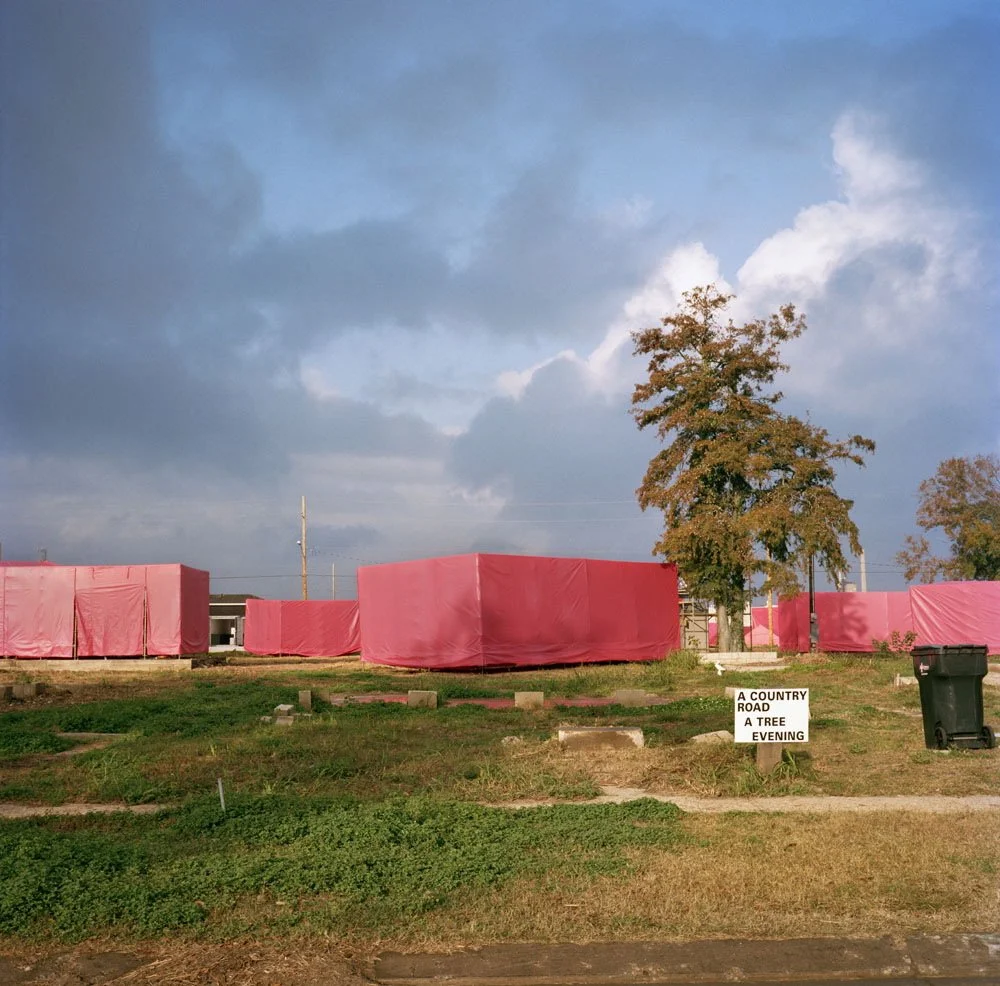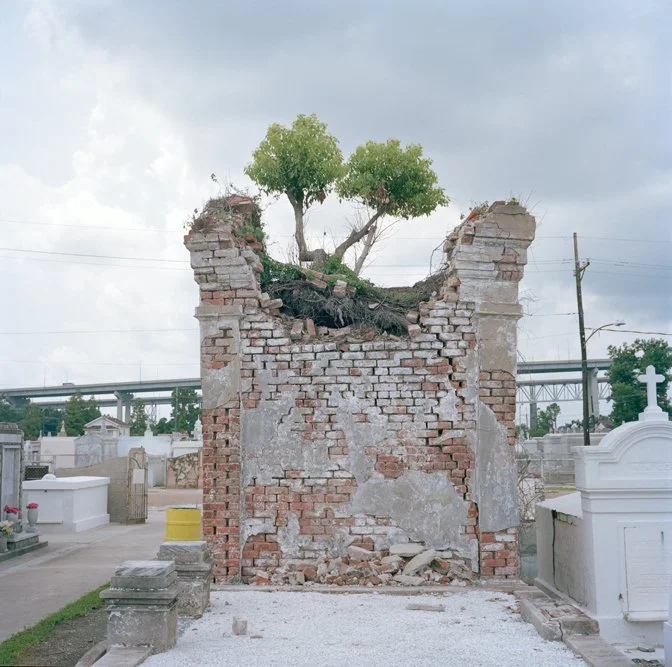Colleen Mullins’ Elysium: Urban Canopy Loss in Post-Katrina New Orleans at the Hands of Man
Originally published on access + ENGAGE, March 2008, Vol. 27, No. 2, ed. Susannah Schouweiler.
When visiting my parents after the destruction caused by Hurricanes Ivan (2004) and Dennis (2005), I was stunned at the transformation of my childhood home. Crews worked to remove wreckage and to replace the debris with new construction. But this was expected. The transience of buildings, especially suburban shopping centers and other recent construction, seems natural. What was truly disorienting was the extent to which the forest landscapes lining highways and abutting neighborhoods had been altered by the storms. It was shocking to see what little remained of hundreds of years worth of natural growth, shredded in a matter of a few short hours. Trees were twisted and torn in unnatural ways, fallen, or just absent. Previously filled space was opened, the tree line thinned. Now, my family’s home is no longer surrounded by thick forest. The yard is all but empty. The few remaining trees seem dislocated by their isolation. This culling of trees has shifted my experience of the space; it no longer feels like the place I grew up. In the absence of the familiar foliage, it is a new place.
A parallel depletion took place in New Orleans during Hurricane Katrina (2005). The photographs of Colleen Mullins’ exhibition Elysium: Urban Canopy Loss, on view at Bethel University’s 9th Street Entry Gallery, depict this loss. Her portraits of trees, survivors of an intense battle with a storm they could not escape, are supplemented with newspaper clippings, personal testimony, and smaller images for context. The damage is, sadly, evident throughout. In Mullins' photographs, the trees appear as amputees. Limbs are conspicuously absent, and we are left to imagine how the phantom foliage once filled out the canopy within these neighborhoods. The mournful quality of this loss is balanced against the strength and perseverance of the remaining umbrage. It is easy to see these photographs as surrogate portraits of the people of the city, but one should be careful not to diminish the way in which the images are truly about the trees and places they inhabit.
Mullins is particularly attentive to the context of her subjects. Her compositions reflect the intertwining of the trees with their urban environments, just as their location binds their fate to the destructive expediency of cleaning crews. In one image, winnowed treetops appear to emerge from the painted tree trunk on a retaining wall. The fullness of the painted tree serves as a haunting counterpoint to the actual tree’s lack of lateral limbs. Several photographs show trees surrounded at the base by a peculiar mulch of rubble and scrap. Not nourished by this, the tree instead becomes a much-abused tool, serving as a backstop for bulldozers scraping up the debris.. In another image, only trunks remain, sawed off at the top, so that power lines can run unhindered overhead. The trunks become two-story stumps, as tall as the adjacent apartment building. Their severed pine branches rest at their feet like clippings under a barber’s chair, ready to be swept away. In the end, the four trees pictured are reduced to likenesses of the utility poles beside them. Other photographs reveal a “y”-shaped canal cut from the top-center of trees to allow wires to pass freely through. These paths carved through the trees by workers restoring power and utilities to the remaining homes and residents may be necessary elements of reconstruction. Unfortunately, they put a priority on speed and human convenience that comes at the expense of further damage to these leafy residents. Mullins’ careful framing of these images accentuates the geometric, ordered, and systematic removal of limbs. This kind of cutting is everything that the storm was not, except merciless.
The decision to carve through the remaining canopy recalls how use and misuse of the land around the city magnifies the damage of the storm to both human and non-human citizens. Mullins’ photographs highlight the complexity of social and environmental choices that lead to this kind of savage pruning. The ruins of the flora reveal the priorities of the culprits behind their demise. While the trees are often treated as obstacles to recovery efforts by city workers, Mullins lays bare our intimate connection to them as part of our sense of place and home. The most ubiquitous image in post-hurricane photography is that of the house branded with the brightly colored “x,” indicating the search status of the property. Similar markings show up in some of her images – spray painted neon circles and "x"'s on trees. The symbol is generally foreboding not unlike the death toll tallied in the quadrants of the home markings. It is portentous that the mode of address for house, tree, and the occasional utility pole might be so similar. In one photograph, a tree stands in front of an empty lot, bearing a blue ribbon and a handmade sign that is simultaneously evocative of a roadside memorial and a yard sale notice. The sign recounts how the trees are all that remain to enable the owner to identify the former location of her house, now just an empty yard. The blue bow becomes yet another color in the litany of memorial ribbons. Another photograph offers the inverse: a tree stands surrounded by bright pink structures, placeholders for future houses. The sign in the front of this yard, a remnant of Paul Chan’s 2007 staging of Waiting for Godot, recounts the stage setting from the play - “A country road, a tree, evening.” The sign, though antecedent, remains on the lot as a kind of counterweight (Godot, after all, never arrives) to the promise of the Project Pink houses. These bold colors and markings stand alongside the trees as both memorial and hope for the future of this place to become home again. But Mullins pictures bear witness to the fact that the structures and their surrounding natural elements will remain forever changed
Mullins' photographs and supplementary materials, along with a web presence that offers the specific geography of these sites using a Google satellite map, direct us to the particularity of this space: as a place of (un)natural ruin, of environmental instability, and as a beloved home. New Orleans is famous for its above-ground cemeteries, built so that burials are not disturbed by the proximity of the water table. In a photograph of one such cemetery, a high brick grave with its top smashed out serves as ther bed for the growth of a new tree. The small tree is a sign of hope and life amidst this tragedy, yet its branches separate into a “y,” recalling the shape of trees with canals cut through their canopy. The hope of this photograph and the city are marked by the travails that razed and reshaped the homes of its inhabitants.
Colleen Mullins
Elysium: Urban Canopy Loss in Post-Katrina New Orleans at the Hands of Man
Feb 29 – April 12, 2008
9th Street Entry Gallery
500 N. Robert St.
Saint Paul, MN 55101


